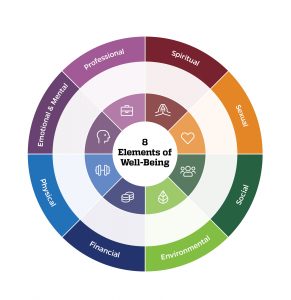Two small (but important) changes
I’m pleased to announce two changes to how Hopkins defines and discusses student health and well-being.
Firstly, we’re changing the URL of this site from wellness.jhu.edu to wellbeing.jhu.edu. (We’ve also updated our Instagram handle to @jhuwellbeing.) The shift from wellness to well-being is multifaceted, but we’re primarily doing it to ensure our terminology is inclusive.
Language is contextual. This means that words have power and particular meanings in the spaces and with the people who are using them. Our community of learners, faculty, and staff is diverse and so there will be variation among and between our populations. As a result, Student Health and Well-Being staff continue to examine the ways in which our words impact our community members and respond accordingly.
The word “wellness” can often be associated with health and can be interpreted to mean an absence of illness or chronic conditions. That interpretation can feel limiting, especially when wellness is considered to be the state to which everyone should aspire. The medicalization of disability and pathologizing of mental health are just two examples where inclusive terms around well-being can help us all think broadly about destigmatizing conversations about our holistic selves. As a result, we foster an empowered community of students and trainees who feel supported.
Secondly, we’re adding an eighth element to our well-being wheel: environmental well-being.
Environmental well-being acknowledges the influence a person’s external surroundings have on other aspects of health. The effects can be positive (spending time in nature lowers blood pressure, reduces stress hormones, and improves overall mood) or negative (exposure to air pollution and other toxins can be harmful).
This dichotomy exists everywhere, but it is particularly evident at our Baltimore campuses. Here, the Hopkins community benefits from curated and exclusive environments that directly benefit our overall well-being. Nature, in the form of tree coverage, colorful plantings, and plentiful shade, offers a respite from the stress of academic life. The built environment gives us comfortable and safe spaces to live, study, work, and play.
Not all of our neighbors can freely access these things.
Wherever you live, it is imperative to recognize that privilege often plays a role in environmental well-being.
To that end, it is our responsibility to protect environmental resources and increase their availability to all communities. This change can happen on institutional and personal levels. At the university level, we are implementing a Climate Action Plan. In parallel with system-wide efforts, individuals can make environmentally conscious consumer choices. They can also advocate against environmental harm and injustice at local, regional, and global levels.
We hope our offices, in partnership with others, can help inform and support students’ efforts. To get started, you can explore the full library of Hopkins environmental well-being resources on this site.
A new URL and a new well-being element are perhaps the most immediately visible elements of the many improvements and changes happening at SHWB. In the forthcoming updates on the recommendations of the Task Force on Mental Health and Well-Being, you can see highlights of new initiatives that prioritize the well-being of students and learners including expanded staffing, more accessible programs to all populations, and new evidence-based programs.
Both these changes were the direct result of student and trainee advocacy. I’d like to particularly thank Giselle-Dior Bourelly (KSAS ‘23) and Anjali Kashyap (KSAS ‘21), who successfully pitched the idea of environmental well-being to the university last year. SHWB welcomes input and feedback on our work; you can email our departmental address, [email protected].
Categories
- Environmental (70)
- Financial (69)
- Mental (223)
- Physical (313)
- Professional (185)
- Sexual (85)
- Social (189)
- Spiritual (26)
Archives
- November 2025
- October 2025
- September 2025
- August 2025
- July 2025
- May 2025
- April 2025
- March 2025
- February 2025
- January 2025
- December 2024
- November 2024
- October 2024
- September 2024
- August 2024
- July 2024
- May 2024
- April 2024
- March 2024
- February 2024
- January 2024
- December 2023
- November 2023
- October 2023
- September 2023
- August 2023
- June 2023
- May 2023
- April 2023
- March 2023
- February 2023
- January 2023
- December 2022
- November 2022
- October 2022
- September 2022
- August 2022
- July 2022
- June 2022
- May 2022
- April 2022
- March 2022
- February 2022
- January 2022
- December 2021
- November 2021
- October 2021
- September 2021
- August 2021
- July 2021
- June 2021
- May 2021
- April 2021
- March 2021
- February 2021
- January 2021
- December 2020
- November 2020
- October 2020
- September 2020
- August 2020
- July 2020
- June 2020
